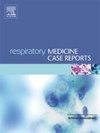抗黑色素瘤分化相关基因5抗体(anti-MDA5)快速进展性间质性肺疾病(RP-ILD)致死性2例:探讨缺陷和差异
IF 0.7
Q4 RESPIRATORY SYSTEM
引用次数: 0
摘要
快速进行性间质性肺病(RP-ILD)在临床实践中是一个关键的挑战,其特点是非特异性症状,尽管进行了强化治疗,但仍可迅速发展为呼吸衰竭。与皮肌炎相关ILD相关的抗黑色素瘤分化相关基因5抗体(anti-MDA5)是此类病例的关键生物标志物。本报告重点介绍了两例抗mda5阳性RP-ILD的死亡病例,强调了诊断和管理方面的挑战。首例病例涉及一名56岁男性,既往无自身免疫性疾病,后来发展为急性呼吸窘迫综合征(ARDS)和多器官衰竭。第二个病例涉及一名49岁的系统性红斑狼疮(SLE)女性,尽管积极治疗,其病情同样以多器官衰竭告终。这两名患者都面临延迟诊断和免疫抑制治疗的次优反应,强调了RP-ILD治疗的复杂性。MDA5的检测周期延长和对非特异性临床指标的依赖仍然是早期诊断的重大障碍。皮肤症状,如Gottron丘疹,虽然是RP-ILD的指示,但与较差的预后相关。目前正在研究的血清生物标志物缺乏MDA5的敏感性和特异性,使早期检测工作复杂化。病情恶化患者的侵袭性免疫抑制常常导致感染性并发症,进一步损害预后。结论为了应对这些挑战,早期识别皮肤病学指标,及时免疫抑制治疗和量身定制的患者管理至关重要。此外,及时转诊体外膜氧合(ECMO)作为肺移植的桥梁可能会提高生存率。推进血清生物标志物的研究有望提高RP-ILD的诊断精度和治疗决策。本文章由计算机程序翻译,如有差异,请以英文原文为准。
Two fatal cases of anti-melanoma differentiation-associated gene 5 antibody (anti-MDA5) rapidly progressive interstitial lung disease (RP-ILD): Exploring pitfalls and differences
Introduction
Rapidly progressive interstitial lung disease (RP-ILD) poses a critical challenge in clinical practice, characterized by nonspecific symptoms that rapidly progress to respiratory failure despite intensive management. Anti-melanoma differentiation-associated gene 5 antibody (anti-MDA5), associated with dermatomyositis-related ILD, is a key biomarker in such cases. This report highlights two fatal cases of anti-MDA5-positive RP-ILD, emphasizing diagnostic and management challenges.
Case presentation
The first case involved a 56-year-old male without prior autoimmune disease who developed acute respiratory distress syndrome (ARDS) and multiorgan failure. The second case concerned a 49-year-old female with systemic lupus erythematosus (SLE), whose condition similarly culminated in multiorgan failure despite aggressive treatment. Both patients faced delayed diagnoses and suboptimal responses to immunosuppressive therapy, underscoring the complexity of managing RP-ILD.
Discussion
Prolonged testing turnaround for MDA5 and reliance on nonspecific clinical indicators remain significant barriers to early diagnosis. Dermatological signs such as Gottron's papules, while indicative of RP-ILD, are associated with poorer prognoses. Current serum biomarkers under investigation lack the sensitivity and specificity of MDA5, complicating early detection efforts. Aggressive immunosuppression in deteriorating patients frequently leads to infectious complications, further compromising outcomes.
Conclusion
To address these challenges, early recognition of dermatological indicators, prompt immunosuppressive therapy, and tailored patient management are critical. Additionally, timely referral for extracorporeal membrane oxygenation (ECMO) as a bridge to lung transplantation may improve survival. Advancing research into serum biomarkers holds promise for enhancing diagnostic precision and therapeutic decision-making in RP-ILD.
求助全文
通过发布文献求助,成功后即可免费获取论文全文。
去求助
来源期刊

Respiratory Medicine Case Reports
RESPIRATORY SYSTEM-
CiteScore
2.10
自引率
0.00%
发文量
213
审稿时长
87 days
 求助内容:
求助内容: 应助结果提醒方式:
应助结果提醒方式:


